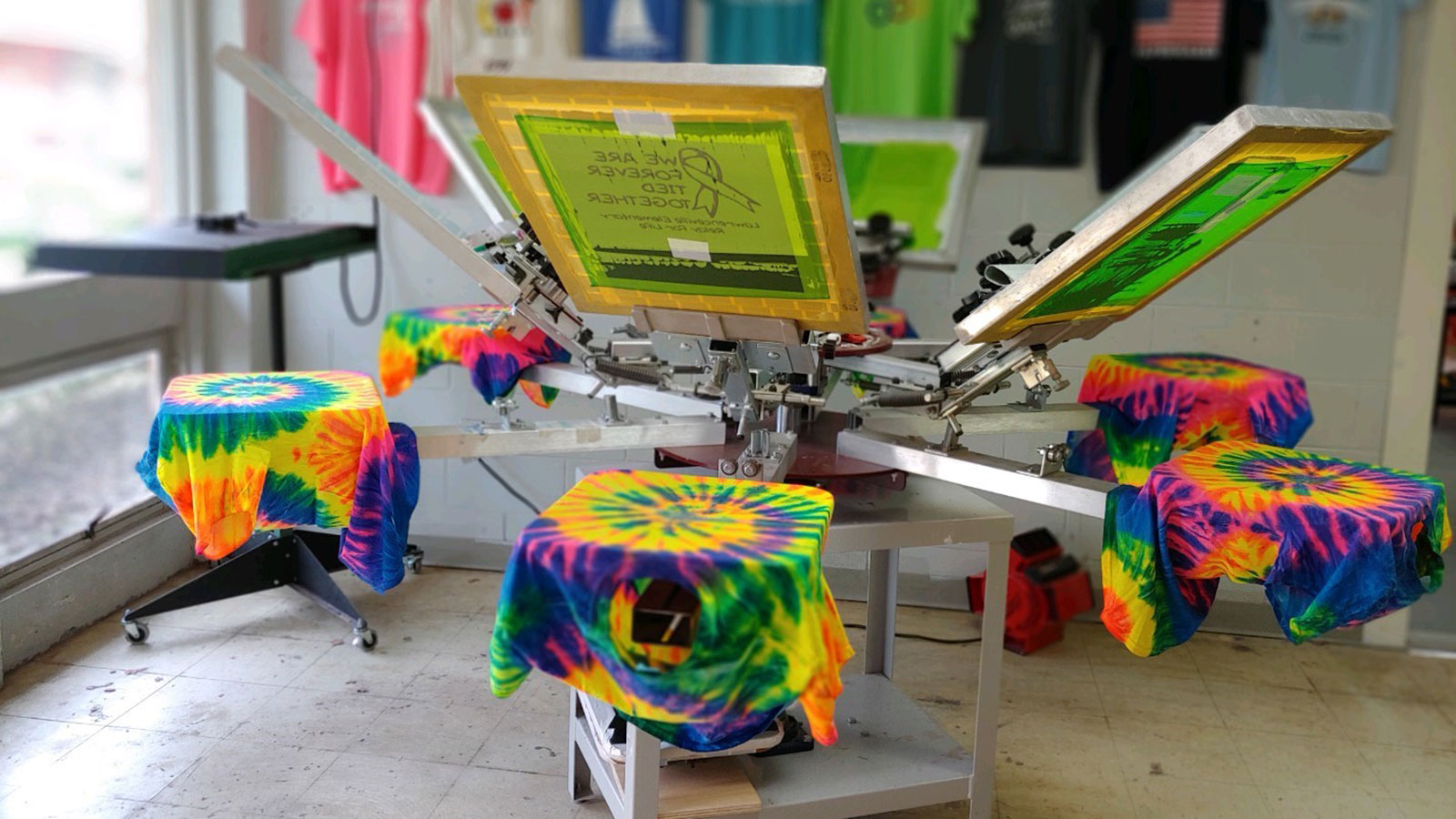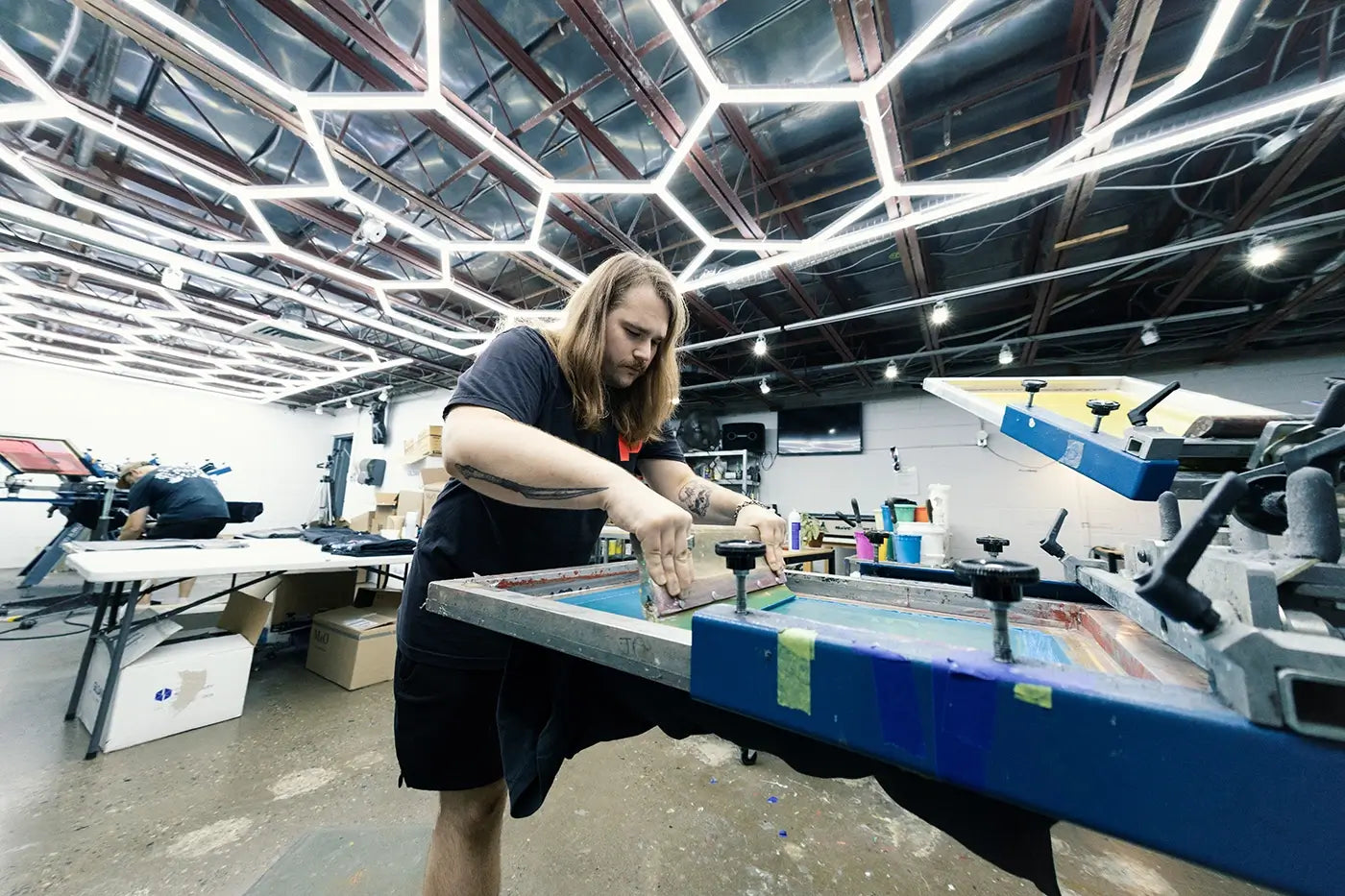Creative T-Shirt Printing Ideas for Small Brands
Wiki Article
Screen Printing Uncovered: Whatever You Required to Learn About Tee and Garment Printing Techniques
If you've ever before wondered exactly how those vibrant layouts end up on your preferred tees, you remain in the right place. Display printing is an interesting method that integrates art with method, supplying endless possibilities for creativity. Recognizing the basics, from equipment to ink selections, can significantly influence your results. Prepared to explore the crucial aspects that make display publishing an art kind? Let's discover the information that can boost your projects.
The Essentials of Display Printing: How It Functions
When you dive into screen printing, you'll discover it's both an art and a scientific research. At its core, display printing includes developing a pattern, or screen, that allows ink to travel through just in specific areas (screen printing kit). You start by choosing your style and preparing your display with a light-sensitive solution. When you subject this solution to light, it sets, leaving your design as an adverse space.Next, you'll blend your inks and prepare your printing surface area. Setting the screen over the material, then make use of a squeegee to push ink with the screen onto the garment. This process needs precision, as you desire clear, dynamic prints. After printing, you'll cure the ink with warmth, guaranteeing it complies with the textile and lasts via cleans. Each action is necessary, and understanding them will boost your display printing abilities, changing simple garments right into one-of-a-kind, expressive items.
Types of Display Printing Techniques
When you realize the basics of display printing, it's time to discover the various strategies that can boost your designs. One preferred method is standard display printing, where ink is pressed through a stenciled display.An additional choice is plastisol printing, recognized for its durability and dazzling shades, making it a favorite for many brand names. Experiment with halftone printing to develop slope effects and detailed styles.
Crucial Equipment for Screen Printing
To achieve sensational lead to screen printing, having the ideal equipment is basic. First, you'll need a sturdy display printing framework, which holds the mesh that transfers your layout onto the garment. Next, buy high-quality mops; these are necessary for using ink evenly across the display. You'll additionally need a great direct exposure device to produce your screens, along with a washout booth for cleansing them after use. A reputable warmth resource, like a conveyor dryer or heat press, is essential for curing your prints to assure longevity. Do not forget a proper work area, equipped with tables and storage space for your materials. Safety gear, such as handwear covers and masks, will keep you secure from chemicals and inks. With the right devices, you'll be well on your way to generating professional-quality prints.Choosing the Right Inks and Products
When choosing inks and materials for screen printing, you require to take into account the sort of ink that works finest for your job. Think about fabric compatibility to ensure your layouts look excellent and last long. Explore green ink alternatives to make your printing process extra sustainable.Kinds Of Display Inks
Picking the right screen ink is essential for attaining vivid, long lasting prints that satisfy your job's demands. There are a number of sorts of display inks to take a look at. Plastisol ink is prominent for its adaptability and convenience of usage, giving outstanding shade opacity on dark materials. Water-based ink, on the various other hand, offers a softer feeling and is green, making it suitable for those wanting to decrease their ecological influence. Discharge inks remove dye from the material, leading to a soft, vintage look yet require certain handling. Specialty inks, such as metal or glow-in-the-dark, can add unique effects to your designs. Evaluate your job demands and choose the ink that straightens best with your desired outcome.Fabric Compatibility Considerations
Understanding textile compatibility is important for attaining high-quality screen prints, specifically given that various products react distinctly to various inks. Constantly test your inks on example textile to assure they stick properly and keep color honesty. Additionally, keep in mind that material weight and appearance can impact the last end result, so picking the ideal ink and material combo is vital for your task's success.Eco-Friendly Ink Options
Eco-friendly inks are becoming a popular choice for display printers who desire to decrease their ecological influence while preserving top quality. When picking inks, take into consideration water-based inks, which are much less unsafe and easier to cleanse up contrasted to standard solvents.Furthermore, search for inks made from sustainable resources, such as soy or vegetable-based alternatives. By picking the ideal inks and materials, you'll not only develop spectacular designs but additionally add to an extra sustainable printing process. Make the button, and your prints will certainly show your commitment to the setting!
Preparing Your Style for Screen Printing

Submit Format Requirements
To guarantee your design looks sharp and vivid on textile, you'll need to pay close focus to file style requirements for screen printing. Make certain your design has a clear history to protect against unwanted white edges on your prints. Maintain shade modes in mind; CMYK is common for screen printing, so transform your RGB develops as necessary.Shade Separation Techniques
Color splitting up is a crucial step in preparing your style for screen printing, and mastering it can considerably improve your print top quality. You'll require to damage your style right into private colors, as each color requires a separate display during printing. Beginning by identifying all the colors in your layout and create layers for each one. You can utilize software application like Adobe Photoshop or Illustrator to separate and separate colors successfully. Be particular to save each layer as a separate documents, generally in a style like TIFF or PSD. This precision not just assures accurate shade depiction yet likewise improves the printing procedure. By focusing on shade separation, you'll accomplish lively and specialist lead to your screen-printed garments.Resolution and Size
Attaining the very best lead to screen printing starts with guaranteeing your style has the best resolution and size. Ideally, your art work should go to least 300 DPI (dots per inch) for sharp, clear prints. Your last product might look pixelated and amateur. if you use reduced resolution.When it pertains to size, take into consideration the measurements of your print area. Layout your art work to match the last print dimension, ideally developing it in the actual dimensions you'll be publishing. By doing this, you'll avoid any kind of unforeseen scaling issues.
Constantly check your layout in both vector and raster styles. Vector graphics can be scaled without losing quality, making them optimal for display printing. Preparing properly will assure your style looks fantastic on every garment!
Step-by-Step Screen Printing Process
Display printing is a vibrant process that enables you to develop vibrant styles on numerous surfaces. To get going, you'll need a screen, solution, and your chosen ink. Prepare your screen by cleansing it extensively. Next, apply the solution equally and let it completely dry in a dark location. Once dry, reveal your screen to light with your style put on it, which will certainly set the emulsion where the light hits, producing a stencil - screen printing kit.After rinsing the unexposed solution, your display prepares. Establish it up on your printing surface area and straighten your garment under it. Put ink onto the screen and use a squeegee to push the ink with the stencil onto the material. Lift the screen very carefully and allow the print completely dry. Finally, cure the ink using warm to ensure resilience. That's it! You have actually efficiently display published your layout.
Tips for Successful Display Printing Projects
While you're diving into your screen printing projects, bear in mind that prep work is vital to success. Begin by gathering all your materials-- inks, displays, garments, and mops. A clean work area assists stop undesirable mistakes, so clean prior to you begin.Next, validate your artwork is high-resolution and appropriately sized for your garment. Test your screen for correct exposure and tidy it thoroughly to avoid smudges. When mixing your inks, adhere to the producer's standards to achieve the right uniformity.
During printing, apply even pressure with your squeegee for consistent results. Don't rush; take your time to verify each print meets your standards. After printing, allow your garments dry totally prior to dealing with or packaging them.
Finally, constantly maintain a sample of your help future recommendation. This method, you can examine your development and boost your methods gradually. Satisfied printing!

Often Asked Inquiries
For how long Does It Require To Establish a Display Printing Work?
Setting up a display printing job usually takes about 30 mins to an hour. You'll prepare the displays, mix inks, and adjust the press. The time varies based on complexity and experience, so stay arranged!Can I Print on Different Textile Enters Using the Exact Same Strategy?
Yes, you can print on different material types making use of the exact same strategy, yet silk screen printing you'll need to change your settings and inks. Some textiles take in ink in a different way, so exploring warranties the finest results for every product.What Prevail Blunders to Prevent in Screen Printing?
When screen printing, avoid common mistakes like using the incorrect ink, disregarding proper exposure times, or skipping pre-press checks. Constantly test your setup and preserve tidy displays to guarantee high quality outcomes each time.Exactly How Can I Effectively Clean and Maintain My Screen Printing Tools?
To appropriately clean and maintain your display printing equipment, you must regularly clean displays with proper solvents, inspect mops for wear, and ensure all tools are kept dry and dust-free. Consistency boosts and protects against expensive repair services efficiency.Is Screen Printing Ecologically Friendly Contrasted to Various Other Techniques?
Display printing can be much more eco-friendly than various other methods, especially if you use water-based inks and eco-conscious products. By choosing lasting materials and practices, you reduce waste and reduce your influence on the planet.Screen Printing Uncovered: Every Little Thing You Need to Know About Tee Shirt and Garment Printing Methods
At its core, screen printing entails creating a stencil, or screen, that permits ink to pass via just in details locations. Setting the display over the fabric, after that utilize a squeegee to push ink via the screen onto the garment. One prominent approach is traditional display printing, where ink is pressed with a stenciled display.When selecting inks and products for display printing, you require to take right into account the kind of ink that functions finest for your project.
Report this wiki page